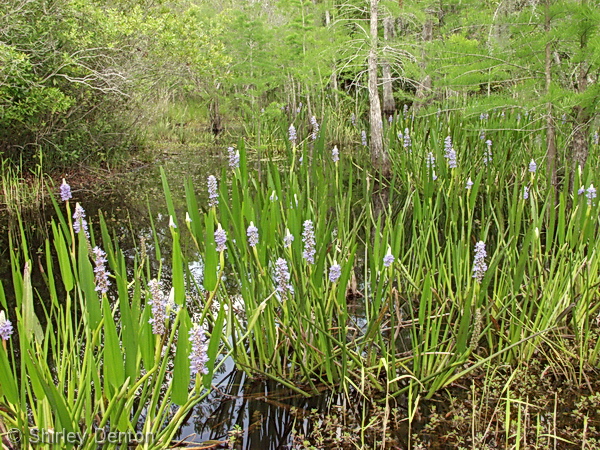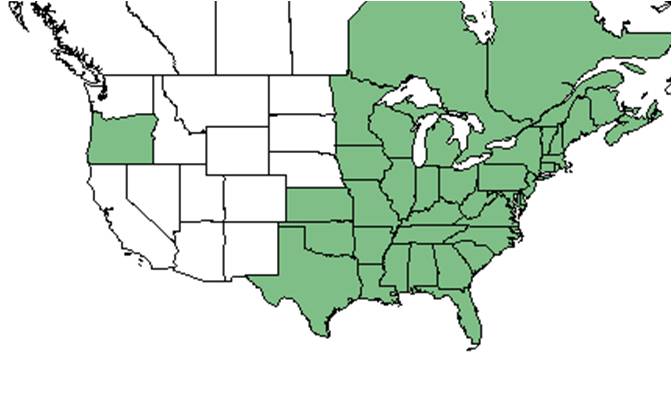Difference between revisions of "Pontederia cordata"
KatieMccoy (talk | contribs) (→Taxonomic notes) |
KatieMccoy (talk | contribs) |
||
| Line 31: | Line 31: | ||
==Ecology== | ==Ecology== | ||
===Habitat=== <!--Natural communities, human disturbed habitats, topography, hydrology, soils, light, fire regime requirements for removal of competition, etc.--> | ===Habitat=== <!--Natural communities, human disturbed habitats, topography, hydrology, soils, light, fire regime requirements for removal of competition, etc.--> | ||
| − | '' | + | Habitats of ''P. cordata'' include mucky soils of river floodplains, an outlet stream to a brackish marsh, shallow river water, cypress swamps, cypress-gum swamps, lake shores, open pools in gum swamps, and a river headwater marsh. It has also been found in disturbed areas such as open roadside ditches, along swamp logging roads, a weedy pond adjacent to a road, modified cypress-sawgrass exposed habitat, mowed roadside ditches, roadside cypress swamps, and the edge of a phosphate pool. Soil types include sandy peat and sandy-clay-alluvium. It has been observed to grow in shaded habitats. Associated species include ''Taxodium, Nyssa aquatica, Fraxinus tomentosa, Serenoa repens, Cyperus odoratus, Paspalum dissectum'', and ''Echinochloa walteri'' (FSU Herbarium). It is used to stabilize pond banks<ref name="illinois">[[http://www.illinoiswildflowers.info/wetland/plants/pickerelweed.htm]]Accessed: January 29, 2016</ref>. |
===Phenology=== <!--Timing off flowering, fruiting, seed dispersal, and environmental triggers. Cite PanFlora website if appropriate: http://www.gilnelson.com/PanFlora/ --> | ===Phenology=== <!--Timing off flowering, fruiting, seed dispersal, and environmental triggers. Cite PanFlora website if appropriate: http://www.gilnelson.com/PanFlora/ --> | ||
Revision as of 13:33, 29 February 2016
| Pontederia cordata | |
|---|---|

| |
| Photo by Shirley Denton (Copyrighted, use by photographer’s permission only), Nature Photography by Shirley Denton | |
| Scientific classification | |
| Kingdom: | Plantae |
| Division: | Magnoliophyta - Flowering plants |
| Class: | Magnoliopsida – Dicotyledons |
| Order: | Commelinales |
| Family: | Pontederiaceae |
| Genus: | Pontederia |
| Species: | P. cordata |
| Binomial name | |
| Pontederia cordata L. | |

| |
| Natural range of Pontederia cordata from USDA NRCS Plants Database. | |
Common name: pickerelweed
Contents
Taxonomic notes
Cordata means heart shaped, Pontederia refers to Italian physician Guilio Pontedera who kept the botanical gardens at Padua for 38 years[1].
Description
A description of Pontederia cordata is provided in The Flora of North America.
Distribution
It is distributed Ontario to Nova Scotia and New England, south to northern Florida, west to Missouri and Oklahoma, north to Minnesota[2].
Ecology
Habitat
Habitats of P. cordata include mucky soils of river floodplains, an outlet stream to a brackish marsh, shallow river water, cypress swamps, cypress-gum swamps, lake shores, open pools in gum swamps, and a river headwater marsh. It has also been found in disturbed areas such as open roadside ditches, along swamp logging roads, a weedy pond adjacent to a road, modified cypress-sawgrass exposed habitat, mowed roadside ditches, roadside cypress swamps, and the edge of a phosphate pool. Soil types include sandy peat and sandy-clay-alluvium. It has been observed to grow in shaded habitats. Associated species include Taxodium, Nyssa aquatica, Fraxinus tomentosa, Serenoa repens, Cyperus odoratus, Paspalum dissectum, and Echinochloa walteri (FSU Herbarium). It is used to stabilize pond banks[3].
Phenology
It has been observed flowering March through November and fruiting April through October (FSU Herbarium). Flowers are blue (FSU Herbarium).
Seed dispersal
Seed bank and germination
Fire ecology
Pollination
The following Hymenoptera families and species were observed visiting flowers of Pontederia cordata at Archbold Biological Station (Deyrup 2015):
Megachilidae: Dianthidium floridiense
Use by animals
Diseases and parasites
Conservation and Management
Cultivation and restoration
Photo Gallery
Flowers of Pontederia cordata Photo by Shirley Denton (Copyrighted, use by photographer’s permission only), Nature Photography by Shirley Denton
References and notes
Deyrup, M.A. and N.D. 2015. Database of observations of Hymenoptera visitations to flowers of plants on Archbold Biological Station, Florida, USA.
Florida State University Robert K. Godfrey Herbarium database. URL: http://herbarium.bio.fsu.edu. Last accessed: November 2015. Collectors: W.P. Adams, Loran C. Anderson, Sydney T. Bacchus, Tom Barnes, J. Beckner, Michael Cartrett, R.F. Christensen, A.F. Clewell, Kathy Craddock Burks, R.F. Christensen, G. Cruz, Delzie Demaree, R.F. Doren, Suellen Folensbee, J.P. Gillespie, Robert K. Godfrey, Bruce Hansen, JoAnn Hansen, N.C. Henderson, R.D. Houk, Meredith Jones, Edwin Keppner, R. Kerstetter, Robert Kral, Robert J. Lemaire, S.W. Leonard, William Lindsey, Sidney McDaniel, Richard S. Mitchell, B. Moore, Gwynn W. Ramsey, P.L. Redfearn Jr., Grady W. Reinert, Deborah R. Shelley, Cecil R. Slaughter, J.N. Triplett Jr., D.B. Ward, Jean W. Wooten, Brian Yahn. States and Counties: Florida: Bay, Brevard, Calhoun, Citrus, Collier, Columbia, DeSoto, Duval, Escambia, Flagler, Franklin, Gadsden, Glades, Gulf, Hamilton, Hillsborough, Holmes, Indian River, Jackson, Jefferson, Lafayette, Lake, Lee, Leon, Levy, Liberty, Madison, Nassau, Okaloosa, Orange, Pinellas, Polk, Putnam, Seminole, Sumter, St. Lucie, St. Johns, Taylor, Volusia, Wakulla, Washington. Countries: Honduras. Compiled by Tall Timbers Research Station and Land Conservancy.
